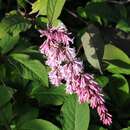en
names in breadcrumbs


Syringa is a genus of 12 currently recognized species of flowering woody plants in the olive family or Oleaceae[1] called lilacs. These lilacs are native to woodland and scrub from southeastern Europe to eastern Asia, and widely and commonly cultivated in temperate areas elsewhere.[2][3][4][5]
The genus is most closely related to Ligustrum (privet), classified with it in Oleaceae tribus Oleeae subtribus Ligustrinae.[6]
Lilacs are used as food plants by the larvae of some moth species, including copper underwing, scalloped oak and Svensson's copper underwing.
They are small trees, ranging in size from 2 to 10 metres (6 ft 7 in to 32 ft 10 in) tall, with stems up to 20 to 30 centimetres (7.9 to 11.8 in) diameter. The leaves are opposite (occasionally in whorls of three) in arrangement, and their shape is simple and heart-shaped to broad lanceolate in most species, but pinnate in a few species (e.g. S. protolaciniata, S. pinnatifolia).
The flowers are produced in spring, each flower being 5 to 10 millimetres (0.20 to 0.39 in) in diameter with a four-lobed corolla, the corolla tube narrow, 5 to 20 millimetres (0.20 to 0.79 in) long; they are monoecious, with fertile stamens and stigma in each flower. The usual flower colour is a shade of purple (often a light purple or "lilac"), but white, pale yellow and pink, and even a dark burgundy color are also found.
The flowers grow in large panicles, and in several species have a strong fragrance. Flowering varies between mid spring to early summer, depending on the species.[3][4][5][7]
The fruit is a dry, brown capsule, splitting in two at maturity to release the two winged seeds.[3][4][5][7]
The English common name "lilac" is from the French lilac[7][8][9] via the Arabic: لِيلَك, romanized: līlak from Persian: ليلنج, romanized: lilanj meaning the indigo plant[10] or نیلک nilak meaning "bluish";[8] both lilanj and nilak come from Persian نیل nīl "indigo" or نیلي nili "dark blue".[10]
The genus Syringa was first formally described in 1753 by Carl Linnaeus and the description was published in Species Plantarum.[11][12] The genus name Syringa is derived from Ancient Greek word syrinx meaning "pipe" or "tube" and refers to the hollow branches of S. vulgaris.[13][14]
Plants of the World Online lists Syringa as a heterotypic synonym of Philadelphus.[11]
Lilacs are popular shrubs in parks and gardens throughout the temperate zone, and several hybrids and numerous cultivars have been developed. The term French lilac is often used to refer to modern double-flowered cultivars, thanks to the work of prolific breeder Victor Lemoine. Lilacs grow most successfully in well-drained soils, particularly those based on chalk.[15] They flower on old wood, and produce more flowers if unpruned. If pruned, the plant responds by producing fast-growing young vegetative growth with no flowers, in an attempt to restore the removed branches. Lilac bushes can be prone to powdery mildew disease.
Lilac wood is not commonly used or commercially harvested due to the small size of the tree[16]. It is a relatively hard wood, with an estimated Janka hardness of 2,350 lbf (10,440 N), and is reportedly good for woodturning [16] The sapwood is typically cream-coloured and the heartwood can have various streaks of brown and purple.[16]
Species have been historically used in various traditional medicines in Asia for treating ailments including cough, diarrhea, acute icteric hepatitis, vomiting, abdominal pain, and bronchitis.[17] Compounds isolated from species of Syringa include phenylpropanoids such as syringin and iridoids such as oleuropein [17]. Substituent compounds, such as iridoids, as well as crude extracts from Syringa plants have been shown to have to have effects including antitumor, antihypertensive, anti-inflammatory, antioxidant, and antifungal activities in pharmacological studies [18].
Lilacs are often considered to symbolize first love.
In Greece, Macedonia, Lebanon, and Cyprus, the lilac is strongly associated with Easter time because it flowers around that time; it is consequently called paschalia.
In the poem When Lilacs Last in the Dooryard Bloom'd, by Walt Whitman, lilacs are a reference to Abraham Lincoln.
Syringa vulgaris is the state flower of New Hampshire, because it "is symbolic of that hardy character of the men and women of the Granite State."[19]

Several locations in North America hold annual Lilac Festivals, including:
Species and subspecies currently accepted as of July 2016:[11][3]
Syringa is a genus of 12 currently recognized species of flowering woody plants in the olive family or Oleaceae called lilacs. These lilacs are native to woodland and scrub from southeastern Europe to eastern Asia, and widely and commonly cultivated in temperate areas elsewhere.
The genus is most closely related to Ligustrum (privet), classified with it in Oleaceae tribus Oleeae subtribus Ligustrinae.
Lilacs are used as food plants by the larvae of some moth species, including copper underwing, scalloped oak and Svensson's copper underwing.